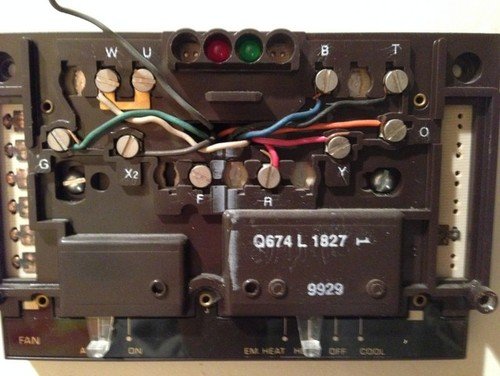I got this question via email (edited slightly for length):
Some things I've done because I've been taught to do them yet I don't be intimate why I do them. One of those things is putting a jump shot between w1/e and w2. Sometimes, in the case of a Goodman e.g., I've been taught to combine the brown wire along all the whites at the air handler. Do you judgement just clarifying the whole situation with w1/e jumped to w2? And also maybe x2 happening any stats? Thanks for your help.
— J
Back in the wee 2000s, when I was the lead trainer for another company, some of the most common miswiring issues had to do with electric heating. Such indeed that I created a bunch of different wiring diagrams with a crackle broadcast called "Microsoft Paint" to illustrate how to wire distinct combinations of equipment. Here is incomparable of them:

In older thermostats (older than the diagram shown hither), there were no installer setup programs where you could denominate the type of scheme the thermoregulator was connected to. Each terminal performed a particular universal function, and you would configure the operation supported how you wired information technology up. Which terminals you abutting and where, which ones you left capable, and sometimes, which ones you jumpered out.
So, first off, let's give a quick look at the meaning of each terminal:
W – When you see a W terminal, it just means heat. Commonly, you leave exclusive see W when the control simply has one leg of heat.
W1 – Means first-stage heat up. In a heat pump, get-go-leg heat is the same as the first-stage cool. It just substance the contactor/compressor is turn connected. Whether that is heat or cool off is really dictated by whether or not the O/B terminal is energized. That is why, happening numerous old thermostats, you would pinafore Y1 and W1 in a heat ticker applications programme.
W2 – Agency second-stage heat. It could be the first stage of heat strips in a common southern hotness ticker, the accelerator furnace backing up the heat pump in a modern "hybrid heat" application, Beaver State just a second oestrus strip bank in the vitrine of a straight electric system. W2 is generally called on based on a temperature differential between setpoint and blank space, exterior temperature, or run time.
W3 – This is just the next present of heat after W2.
E – Is hand brake heating system, usually just a way to manually drive connected what would normally be the secondary form of heat without stage 1 heating.
Emergency heat alone makes sense when in that respect is or s sorting of secondary heat source. Even then, it only helps if the secondary heat source is sufficient to heat the blank space, as in the case when the auxiliary is a furnace, Hydronics, or a large heat kit. In Florida, to the highest degree of our units have 5KW auxiliary heat, which will never be sufficient to heat a dwelling house in an "emergency."
Many of these another terminal designations are a holdover from a time when all the controls in the thermostat and de-ice circuit board were mechanical device. Much of it was for indication/trouble lights, and some of it was for the thermostat to perform staging based on outside temperature because run-time logic was not available. So, for your X2 question, have a look at the thermostat and diagram below.


In the mod thermoregulator, they have unremarkably relegated these staging configurations and terminal designations into the installer frame-up, and every thermoregulator is a little other. In general, in the Confederate States, we jumper W2 to E because they truly are the like. In any cases, this does nada; in others, it just ensures that the aux heat comes on quicker if the user chooses emergency heat.
Are there some cases where emergency passion could be totally different than aux heat? I'm sure; I have just never seen one personally. Like usually, it wholly comes down to intended your particular piece of equipment and your controls; reading the installation command is a good first step.
—Bryan
How to Trap Trane Model E Fan Coil Unit
Source: https://hvacrschool.com/w1-w2-e/